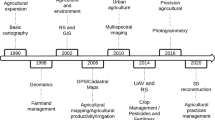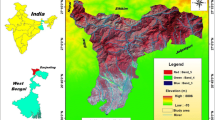Abstract
Land use classification is often the first step in land use studies and thus forms the basis for many earth science studies. In this paper, we focus on low-cost techniques for combining Landsat images with geographic information system approaches to create a land use map. In the Golestan region of Iran, we show that traditional supervised and unsupervised methods do not result in sufficiently accurate land use maps. Therefore, we evaluated a synthetic approach combining supervised and unsupervised methods with decision rules based on easily accessible ancillary data. For accuracy assessment, confusion matrices and kappa coefficients were calculated for the maps created with the supervised, unsupervised and synthetic approaches. Overall accuracy of the synthetic approach was 98.2 %, which is over the 85 % level that is considered satisfactory for planning and management purposes. This shows that integration of remote sensing data, ancillary data and decision rules provides better classification accuracy than traditional methods, without significant additional use of resources.










Similar content being viewed by others
References
Abd el-kawy OR, Ismail HA, Suliman AS (2011) Land use and land cover change detection in the western Nile delta of Egypt using remote sensing data. Appl Geogr 31(2):483–494
Alesheikh AA, Ghorbanali A, Nouri N (2007) Coastline change detection using remote sensing. Int J Environ Sci Technol 4(1):61–66
Alrababah MA, Alhamad MN (2006) Land use/cover classification of arid and semi-arid mediterranean landscapes using Landsat ETM. Int J Remote Sens 27(13):2703–2718
Anderson JR, Hardy EE, Roach JT, Witmer RE (1976) A land use and land cover classification system for use with remote sensor data. U.S. Geological survey, Washington, DC, No. Professional paper 964
Bakr N, Weindorf DC, Bahnassy MH, Marei SM, El-badawi MM (2010) Monitoring land cover changes in a newly reclaimed area of Egypt using multitemporal Landsat data. Appl Geogr 30(4):592–605
Brandt JS, Haynes MA, Kuemmerle T, Waller DM, Radeloff VC (2013) Regime shift on the roof of the world: alpine meadows converting to shrublands in the southern Himalayas. Biol Conserv 158:116–127
Cetin M (2009) A satellite based assessment of the impact of urban expansion around a lagoon. Int J Environ Sci Technol 6(4):579–590
Chen J, Zhu X, Vogelmann JE, Gao F, Jin S (2011) A simple and effective method for filling gaps in Landsat ETM+ slc-off images. Remote Sens Environ 115(4):1053–1064
Cingolani AA, Renison D, Zak MR, Cabido MR (2004) Mapping vegetation in a heterogeneous mountain rangeland using Landsat data: an alternative method to define and classify land-cover units. Remote Sens Environ 92(1):84–97
Cohen WB, Goward SN (2004) Landsat’s role in ecological applications of remote sensing. Bioscience 54(6):535–545
Foody GM (2002) Status of land cover classification accuracy assessment. Remote Sens Environ 80(1):185–201
Golestan Regional Water Co (2007) Golestan province meteorological information report
Hansen MC, Roy DP, Lindquist E, Adusei B, Justice CO, Altstatt A (2008) A Method for integrating Modis and Landsat data for systematic monitoring of forest cover and change in the Congo basin. Remote Sens Environ 112(5):2495–2513
Huang C, Goward SN, Masek JG, Thomas N, Zhu Z, Vogelmann JE (2010) An automated approach for reconstructing recent forest disturbance history using dense Landsat time series stacks. Remote Sens Environ 114(1):183–198
Hudson W, Ramm C (1987) Correct formula of the kappa coefficient of agreement. Photogramm Eng Remote Sens 53(4):421–422
Koutsias N, Karteris M (2003) Classification analyses of vegetation for delineating forest fire fuel complexes in a Mediterranean test site using satellite remote sensing and GIS. Int J Remote Sens 24(15):3093–3104
Lillesand TM, Kiefer RW (2000) Remote sensing and image interpretation. Wiley, New York, p 724
Liu K, Shi W, Zhang H (2011) A fuzzy topology-based maximum likelihood classification. J Photogramm Remote Sens 66(1):103–114
Manandhar R, Odeh IOA, Ancev T (2009) Improving the accuracy of land use and land cover classification of Landsat data using post-classification enhancement. Remote Sens 1(13):330–344
Masek JG, Huang CQ, Wolfe R, Cohen W, Hall F, Kutler J, Nelson V (2008) North American forest disturbance mapped from a decadal Landsat record. Remote Sens Environ 112(6):2914–2926
Maxwell SK, Sylvester KM (2012) Identification of “ever-cropped” land (1984–2010) using Landsat annual maximum NDVI image composites: southwestern Kansas case study. Remote Sens Environ 121:186–195
Mohammady M, Pourghasemi HR, Pradhan B (2012) Landslide susceptibility mapping at Golestan province, Iran: a comparison between frequency ratio, Dempster–Shafer, and weights-of-evidence models. J Asian Earth Sci 61:221–236
Mohammady M, Moradi HR, Zeinivand H, Temme AJAM, Pourghasemi HR, Alizadeh H (2013) Validating gap-filling of Landsat ETM + satellite images in the Golestan Province, Iran, Arabian. J Geosci. doi:10.1007/s12517-013-0967-5
Otukei JR, Blaschke T (2010) Land cover change assessment using decision trees, support vector machines and maximum likelihood classification algorithms. Int J Appl Earth Obs 12(1):27–31
Petropoulos P, Kontoes C, Keramitsoglou I (2012) Land cover mapping with emphasis to burnt area delineation using co-orbital ali and Landsat TM imagery. Int J Appl Earth Obs 18:344–355
Prishchepov AV, Radeloff VC, Dubinin M, Alcantara C (2012) The effect of Landsat ETM/ETM+ image acquisition dates on the detection of agricultural land abandonment in eastern Europe. Remote Sens Environ 126:195–209
Rojas C, Pino J, Basnou C, Vivanco M (2013) Assessing land-use and -cover changes in relation to geographic factors and urban planning in the metropolitan area of concepcion (Chile). Implications for biodiversity conservation. Appl Geogr 39:93–103
Rosenfield G, Fitzpatrick-lins K (1986) A coefficient of agreement as a measure of thematic classification accuracy. Photogramm Eng Remote Sens 52(2):223–227
Rozenstein O, Karnieli A (2010) Comparison of methods for land-use classification incorporating remote sensing and GIS inputs. Appl Geogr 31(2):533–544
Schmitt-harsh M (2013) Landscape change in Guatemala: driving forces of forest and coffee agroforest expansion and contraction from 1990 to 2010. Appl Geogr 40:40–50
Schulz J, Cayuela L, Echeverria C, Salas J, Rey Benayas JM (2010) Monitoring land cover change of the dryland forest landscape of central Chile (1975–2008). Appl Geogr 30(3):436–447
Sexton JO, Urban DL, Donohue MJ, Song C (2013) Long-term land cover dynamics by multi-temporal classification across the Landsat-5 record. Remote Sens Environ 128:246–258
Shalaby A, Tateishi R (2007) Remote sensing and GIS for mapping and monitoring land cover and land-use changes in the northwestern coastal zone of Egypt. Appl Geogr 27(1):28–41
Stefanov WL, Ramsey MS, Christensen PR (2001) Monitoring urban land cover change: an expert system approach to land cover classification of semiarid to arid urban centers. Remote Sens Environ 77(2):173–185
Sun J, Yang J, Zhang C, Yun W, Qu J (2011) Automatic remotely sensed image classification in a grid environment based on the maximum likelihood method. Math Comput Model. doi:10.1016/j.mcm.2011.10.063
Turner MD, Congalton RG (1998) Classification of multi-temporal spot-xs satellite data for mapping rice fields on a West African floodplain. Int J Remote Sens 19(1):21–41
Wang J, Rich PM, Price KP, Kettle WD (2005) Relations between NDVI, grassland production, and crop yield in the central Great Plains. Geocarto Int 20(3):5–11
Wilkinson GG (2005) Results and implications of a study of fifteen years of satellite image classification experiments. IEEE Geosci Remote Sens 43(3):433–440
Wolter PT, Mladenoff DJ, Host GE, Crow TR (1995) Improved forest classification in the northern lake states using multi-temporal Landsat imagery. Photogramm Eng Remote Sens 61(9):1129–1144
Yiqiang G, Yanbin W, Zhengshan J, Jun W, Luyan Z (2010) Remote sensing image classification by the chaos genetic algorithm in monitoring land use changes. Math Comput Model 51(11):1408–1416
Zegre NP, Maxwell A, Lamont A (2013) Characterizing stream flow response of a mountaintop-mined watershed to changing land use. Appl Geogr 39:5–15
Acknowledgments
The author would like to thank the Tarbiat Modares University for financial support. The authors also are grateful to spatial academy (www.spatialacademy.com) team for technical support in GIS and remote sensing.
Author information
Authors and Affiliations
Corresponding author
Rights and permissions
About this article
Cite this article
Mohammady, M., Moradi, H.R., Zeinivand, H. et al. A comparison of supervised, unsupervised and synthetic land use classification methods in the north of Iran. Int. J. Environ. Sci. Technol. 12, 1515–1526 (2015). https://doi.org/10.1007/s13762-014-0728-3
Received:
Revised:
Accepted:
Published:
Issue Date:
DOI: https://doi.org/10.1007/s13762-014-0728-3




